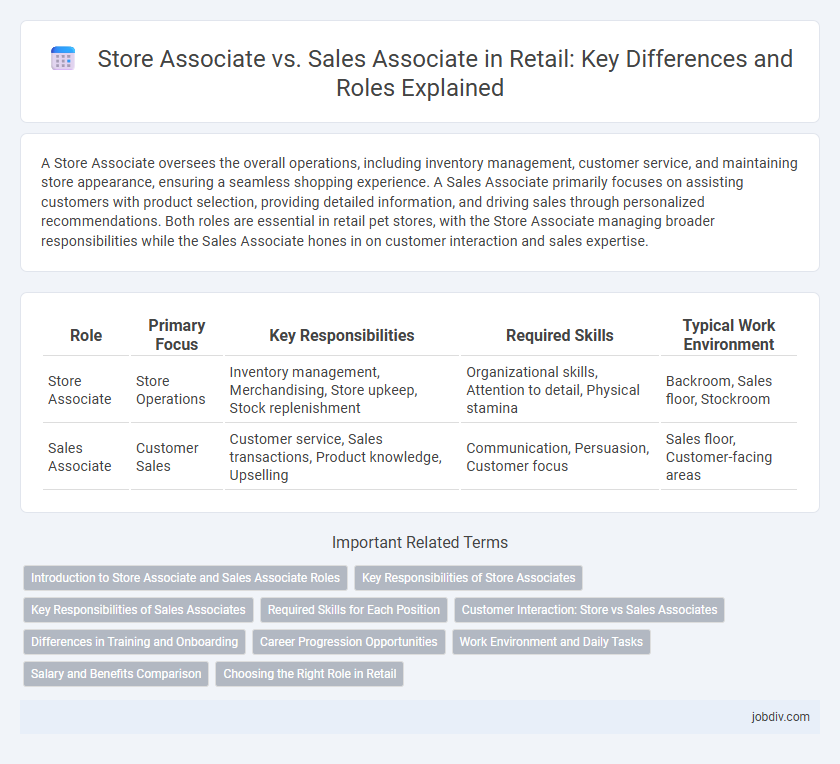A Store Associate oversees the overall operations, including inventory management, customer service, and maintaining store appearance, ensuring a seamless shopping experience. A Sales Associate primarily focuses on assisting customers with product selection, providing detailed information, and driving sales through personalized recommendations. Both roles are essential in retail pet stores, with the Store Associate managing broader responsibilities while the Sales Associate hones in on customer interaction and sales expertise.
Table of Comparison
| Role | Primary Focus | Key Responsibilities | Required Skills | Typical Work Environment |
|---|---|---|---|---|
| Store Associate | Store Operations | Inventory management, Merchandising, Store upkeep, Stock replenishment | Organizational skills, Attention to detail, Physical stamina | Backroom, Sales floor, Stockroom |
| Sales Associate | Customer Sales | Customer service, Sales transactions, Product knowledge, Upselling | Communication, Persuasion, Customer focus | Sales floor, Customer-facing areas |
Introduction to Store Associate and Sales Associate Roles
Store Associates manage inventory, assist customers with product inquiries, and ensure the sales floor is organized, contributing directly to store operations and customer satisfaction. Sales Associates focus on engaging customers, understanding their needs, and driving sales through personalized service and product recommendations. Both roles are essential in retail environments to enhance the shopping experience and optimize business performance.
Key Responsibilities of Store Associates
Store Associates are responsible for maintaining store appearance, managing inventory, and providing customer service, ensuring a smooth in-store experience. They handle restocking shelves, organizing displays, and assisting with store operations, including cash handling and opening or closing tasks. Their role often extends to supporting sales associates by addressing customer inquiries and facilitating seamless transactions.
Key Responsibilities of Sales Associates
Sales associates primarily engage with customers by providing product information, handling transactions, and ensuring a positive shopping experience to drive sales and customer satisfaction. They manage inventory restocking, organize merchandise displays, and assist in maintaining store cleanliness to support operational efficiency. Effective communication skills and a thorough knowledge of product offerings are essential for sales associates to meet daily sales targets and foster customer loyalty.
Required Skills for Each Position
Store Associates require strong organizational skills, inventory management expertise, and proficiency with point-of-sale systems to ensure smooth store operations. Sales Associates need excellent communication and customer service skills, product knowledge, and the ability to build rapport to effectively drive sales. Both positions demand problem-solving abilities and teamwork but differ in their emphasis on operational tasks versus direct customer interaction.
Customer Interaction: Store vs Sales Associates
Store Associates engage with customers by providing in-person assistance, managing inventory, and facilitating store operations to enhance the shopping experience. Sales Associates primarily focus on driving sales through personalized product recommendations, upselling, and building customer relationships both in-store and via digital channels. Customer interaction for Store Associates is hands-on and operational, while Sales Associates prioritize direct engagement aimed at converting interest into purchases.
Differences in Training and Onboarding
Store Associates undergo comprehensive training focused on store operations, inventory management, and customer service protocols specific to the retail environment, while Sales Associates receive targeted sales techniques, product knowledge, and customer interaction skills tailored to driving sales. Onboarding for Store Associates typically includes learning store layout, merchandising standards, and safety procedures, whereas Sales Associates concentrate on mastering product features, sales goals, and upselling strategies. These differences ensure each role is equipped with the specialized skills necessary to optimize overall store performance and customer satisfaction.
Career Progression Opportunities
Store Associates typically manage inventory, organize displays, and assist with store operations, providing foundational retail experience crucial for advancement. Sales Associates focus primarily on customer interactions and driving sales, developing skills in communication and product knowledge that are essential for moving into supervisory or specialist roles. Career progression for Store Associates often leads to roles like Store Supervisor or Inventory Manager, while Sales Associates may advance to positions such as Sales Manager or Customer Experience Leader.
Work Environment and Daily Tasks
Store Associates typically manage inventory, organize merchandise, and maintain store cleanliness in a fast-paced retail environment, ensuring shelves are stocked and displays are attractive. Sales Associates focus on direct customer interaction, providing product information, answering queries, and facilitating transactions to enhance the shopping experience. Both roles require teamwork and communication but differ in emphasis: Store Associates prioritize operational duties while Sales Associates concentrate on customer service and sales performance.
Salary and Benefits Comparison
Store associates typically earn an average hourly wage ranging from $12 to $18, while sales associates often receive between $10 and $16 per hour, reflecting slight variations based on responsibilities and location. Store associates may benefit from comprehensive perks such as healthcare plans, employee discounts, and paid time off, whereas sales associates usually access more basic benefits with fewer additional incentives. Salary and benefits packages for both roles vary significantly by retail employer size and geographic region, impacting overall compensation competitiveness.
Choosing the Right Role in Retail
Store Associates manage overall store operations, inventory, and customer service, ensuring smooth day-to-day functionality, while Sales Associates focus primarily on engaging customers, promoting products, and closing sales. Choosing the right role depends on whether you prefer operational responsibilities with a broader scope or direct customer interaction centered on driving sales. Retail professionals should evaluate skills like multitasking and team leadership for Store Associate roles versus persuasive communication and product knowledge for Sales Associate positions.
Store Associate vs Sales Associate Infographic

 jobdiv.com
jobdiv.com